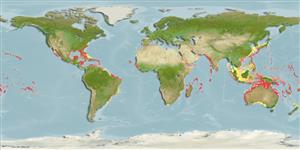Malacostraca |
Stomatopoda |
Pseudosquillidae
Environment: milieu / climate zone / depth range / distribution range
Ecology
Reef-associated; depth range 0 - 69 m (Ref. 80410). Tropical
Indo-Pacific and Atlantic Ocean. Tropical and subtropical.
Length at first maturity / Size / Weight / Age
Maturity: Lm ? range ? - ? cm Max length : 12.5 cm TL male/unsexed; (Ref. 3424)
Minimum depth from Ref. 83920. This species is found on rocky and sandy bottoms, particularly in intertidal and subtidal areas (Ref. 83920).
Life cycle and mating behavior
Maturity | Reproduction | Spawning | Eggs | Fecundity | Larvae
Some members of the order Stomatopoda pair for life and some come together only to mate. Males produce sperm ducts rather than spermatophores; females can brood a maximum of 50,000 eggs. Life cycle: Eggs hatch to a planktonic zoea which lasts for 3 months.
Ahyong, S.T. 2001. (Ref. 3099)
IUCN Red List Status (Ref. 130435)
CITES status (Ref. 108899)
Not Evaluated
Not Evaluated
Threat to humans
Harmless
Human uses
| FishSource |
Tools
More information
Age/Size
Growth
Length-weight
Length-length
Morphology
Larvae
Abundance
Internet sources
Estimates based on models
Preferred temperature
(Ref.
115969): 22.1 - 28.6, mean 27 (based on 1156 cells).
Vulnerability
Low vulnerability (10 of 100).
